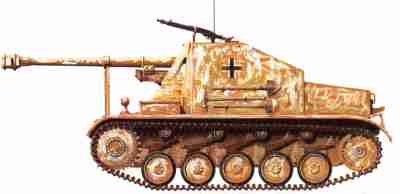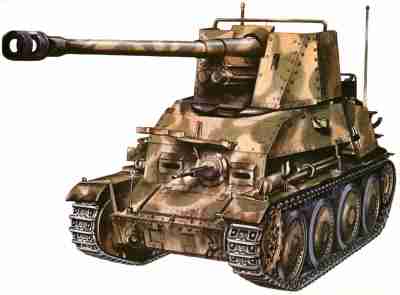

Marder I
Marder was the general name assigned to a "family" of six open-topped tank destroyers produced
between 1942-45. The Marder I used captured French Lorraine tractor chassis to act as a
basis for a tall, lightly-armored compartment mounting a 75mm PaK 40 anti-tank gun with
the splinter shield. The Marder I, after 184 in total were built, served in Russia in
1942 with disastrous results. Thus they were all later redeployed to France for
occupation duties.


Marder II
The Marder II used the chassis of the
PzKpfw IIB and had two versions.
The first had a 75mm PaK 40 mounted in an open-topped fighting compartment at the front
of the hull. The second used a captured Russian 76.2mm gun with splinter shield in the middle
of the hull top. The former had a production run of 730 and the latter about 150, depending
on how many guns were captured.


Marder III
The Marder IIIs were the best in the family, and there were three versions. All used the chassis of the
ubiquitous Czech
LT-38. The first carried a 75mm PaK 40 in a three-sided
compartment at the front of the hull. Thus they were nose-heavy, so only 418 were manufactured. The
second type had the compartment moved to the rear in 1943 and 799 were produced. The third carried the
Russian 76.2mm gun in the middle of the hull in a similar open-topped fighting compartment.
The Marders were, unlike the Sturmgeschütz and Jagdpanzer types, which were custom-desgined
to meet a specification, merely hasty improvizations to help equalize the imbalance of armor on the
Eastern front. Although they packed a heavy punch, the lack of adequate protection for crewmen and high
silhouettes rendered them vulnerable to conventional artillery, anti-tank guns, tank guns and even
small-arms fire. Many were allocated to Fallschirmjäger units (paratroopers) in Russia, which were
Luftwaffe formations.
Back to German Tank Destroyers/Assault Guns Page
Back to Heer Page
Back to Homepage